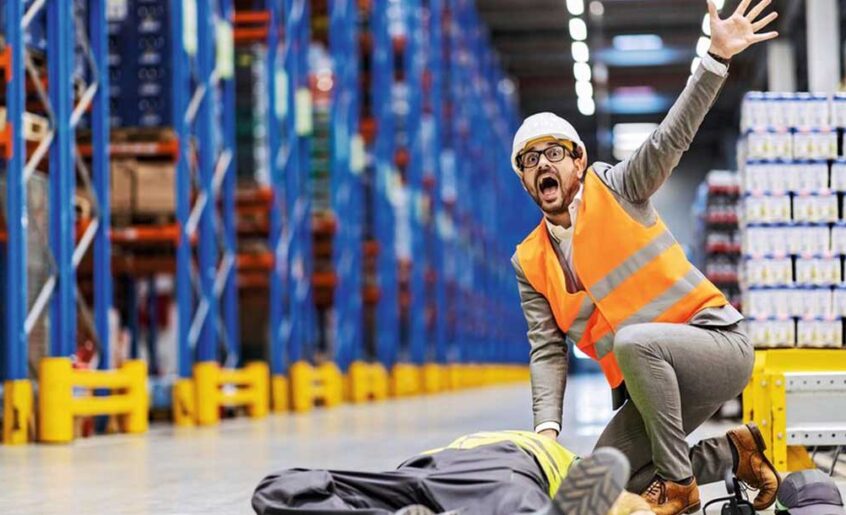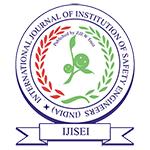How To Control To Industrial Accident

Volume 6, Issue 1, January-March 2023
How To Control To Industrial Accident
Abdulmunam Al-Mehaif
Health, Safety & Environment Cordinator – ARAMCO
Email id: mehaif@hotmail.com
Abstract
This paper presents an overview of strategies that can be employed to control industrial accidents in the workplace. The focus is on identifying potential hazards and implementing measures to prevent and mitigate accidents. The paper discusses the importance of conducting regular risk assessments and implementing safety protocols to reduce the risk of accidents. Training and education programs are also highlighted as critical tools for raising awareness and ensuring that employees are prepared to respond to emergencies.
Additionally, the paper emphasizes the need for regular maintenance and inspection of equipment and facilities to prevent malfunctions and identify potential safety hazards. Creating a culture of safety in the workplace is also discussed as a way to promote safe behavior and encourage employees to take responsibility for their own safety and that of their colleagues.
Finally, the paper recommends the development and implementation of emergency response plans to ensure that everyone in the workplace knows what to do in the event of an accident or emergency. Overall, this paper provides practical guidance for controlling industrial accidents and creating a safe and productive workplace for all employees.
Keywords: Industrial Accidents, Accident Prevention, Workplace Safety, Risk Assessment, Risk Control, Hazard control, Safety management
1. INTRODUCTION
Industrial accidents can have severe consequences, including injury or loss of life, damage to equipment and facilities, and financial losses. As such, controlling and preventing industrial accidents is a critical concern for businesses and organizations across various industries. This paper provides an overview of strategies that can be employed to control industrial accidents in the workplace.
The paper begins by discussing the importance of conducting regular risk assessments to identify potential hazards and implementing safety protocols to reduce the risk of accidents. Training and education programs are also highlighted as essential tools for raising awareness and ensuring that employees are prepared to respond to emergencies.
Additionally, the paper emphasizes the need for regular maintenance and inspection of equipment and facilities to prevent malfunctions and identify potential safety hazards. Creating a culture of safety in the workplace is also discussed as a way to promote safe behavior and encourage employees to take responsibility for their own safety and that of their colleagues.
Finally, the paper recommends the development and implementation of emergency response plans to ensure that everyone in the workplace knows what to do in the event of an accident or emergency.
Overall, this paper provides practical guidance for controlling industrial accidents and creating a safe and productive workplace for all employees. By implementing these strategies, organizations can reduce the risk of accidents and protect their employees, equipment, and facilities.
2. HOW CAN ACCIDENT BE CONTROLLED AT WORKPLACE
Accidents can be controlled in the workplace by implementing a combination of strategies that focus on identifying potential hazards and reducing the risk of accidents. The following are some key strategies for controlling accidents in the workplace:
- Conduct regular risk assessments: Conducting regular risk assessments can help identify potential hazards and risks in the workplace. This includes identifying hazardous materials, unsafe work practices, and equipment that may pose a risk to employees.
- Implement safety protocols: Once potential hazards are identified, safety protocols should be implemented to reduce the risk of accidents. This includes providing personal protective equipment (PPE), safety guards on equipment, and signage to alert employees to potential hazards.
- Provide training and education: Regular training and education programs should be provided to employees to ensure that they are aware of safety protocols and know how to respond in the event of an accident or emergency.
- Conduct regular maintenance and inspection: Regular maintenance and inspection of equipment and facilities can help prevent malfunctions and identify potential safety hazards before they become serious issues.
- Foster a safety culture: Creating a culture of safety in the workplace can help promote safe behavior and encourage employees to take responsibility for their own safety and that of their colleagues.
- Develop and implement emergency response plans: Having an emergency response plan in place can help ensure that everyone in the workplace knows what to do in the event of an accident or emergency.
By implementing these strategies, accidents can be controlled and prevented in the workplace, ensuring a safe and productive work environment for all employees.
3. HOW CAN INDUSTRIAL HAZARDS BE CONTROLLED?
Industrial hazards can be controlled through various methods, including:
- Engineering controls: These are modifications to equipment, processes, or facilities that aim to eliminate or reduce hazards. Examples include machine guards, ventilation systems, and automated safety devices.
- Administrative controls: These are policies, procedures, and training programs that aim to reduce hazards through changes to work practices or work organization. Examples include job rotation, safe work procedures, and training programs.
- Personal protective equipment (PPE): PPE is worn by workers to protect them from specific hazards, such as chemical exposure, noise, or physical impact. Examples of PPE include gloves, respirators, and hard hats.
- Hazard communication: Employers are required to communicate information about hazards to workers. This includes providing Material Safety Data Sheets (MSDS) for hazardous materials and warning labels on equipment or containers.
- Emergency preparedness: Employers must have emergency plans and procedures in place to respond to accidents, spills, or other hazardous incidents. These plans should be regularly reviewed and updated.
- Regular inspection and maintenance: Regular inspection and maintenance of equipment and facilities can identify potential hazards and allow for their timely repair or replacement.
By employing these methods, industrial hazards can be effectively controlled, minimizing the risk of accidents, injuries, and illnesses in the workplace. 1Elimination such as eliminate or kill to potential source of harm or situation, 2Substitution such as substitute to Process or material or method of work, 3Engineering Control such as use of guard, remote sensing devices etc. 4Administrative Control such as training, Supervision, enforcement to rules & regulation & 5Use of Personnel Protective equipment is also known as hierarchy of hazard control. This method is most popular and use to control to industrial hazard and ensure safe work place to prevent any potential future harm.
4. CONCLUSION
In conclusion, controlling industrial accidents and hazards in the workplace is a critical concern for organizations across various industries. By implementing strategies such as regular risk assessments, safety protocols, training and education programs, maintenance and inspection, safety culture, and emergency response planning, organizations can effectively control and prevent accidents and hazards.
It is essential for employers to prioritize safety in the workplace and create a culture that values safety and encourages employees to take responsibility for their own safety and that of their colleagues. Through a combination of engineering and administrative controls, personal protective equipment, hazard communication, emergency preparedness, and regular inspection and maintenance, industrial hazards can be effectively controlled, ensuring a safe and productive workplace for all employees.
Overall, organizations that prioritize safety and take proactive steps to control and prevent accidents and hazards will benefit from improved productivity, reduced absenteeism and turnover, and a positive reputation among employees and stakeholders.
5. RECCOMENDATION
- Based on the strategies discussed in this paper for controlling industrial accidents and hazards in the workplace, the following recommendations are made:
- Conduct regular risk assessments and implement safety protocols to reduce the risk of accidents and hazards.
- Provide regular training and education programs to employees to ensure they are aware of safety protocols and know how to respond in the event of an accident or emergency.
- Regularly maintain and inspect equipment and facilities to prevent malfunctions and identify potential safety hazards before they become serious issues.
- Foster a safety culture in the workplace that promotes safe behavior and encourages employees to take responsibility for their own safety and that of their colleagues.
- Develop and implement emergency response plans to ensure everyone in the workplace knows what to do in the event of an accident or emergency.
- Regularly review and update safety policies and procedures to ensure they remain effective and relevant.
- Encourage employees to report safety concerns or hazards, and promptly address any reported concerns.
- By implementing these recommendations, organizations can effectively control industrial accidents and hazards in the workplace, ensuring a safe and productive work environment for all employees.
Proactive approach such as Hazard identification & Risk assessment, Job Safety Analysis, Safe Operating Procedure, Safety Management plan, Emergency preparedness plan etc are very helpful to control to industrial accident. This will be effective if prepare by well experiences and qualified personnels and ensure strictly compliance as per these documents on regular basis.
6. SUGGESTIONS
Based on the strategies and recommendations discussed in this paper, here are some additional suggestions for controlling industrial accidents and hazards in the workplace:
- Try to identify potential sources of accident & associated risk proactively & ensure effective Safety measure as per existing risk.
- Regularly review and update safety training and education programs to ensure they remain current and effective.
- Consider using technology, such as sensors or automated safety devices, to enhance safety in the workplace.
- Involve employees in the development and implementation of safety policies and procedures to increase their engagement and ownership.
- Conduct regular safety audits to evaluate the effectiveness of safety measures and identify areas for improvement.
- Ensure that all employees, including contractors and visitors, receive safety training and are aware of safety protocols in the workplace.
- Consider establishing a safety committee or team to oversee safety initiatives and promote a culture of safety in the workplace.
- Provide incentives for employees who consistently demonstrate safe behavior and adhere to safety protocols.
- By implementing these suggestions, organizations can further enhance their efforts to control industrial accidents and hazards in the workplace, promoting a safe and productive work environment for all employees.
REFERENCES
- Occupational Safety and Health Administration (OSHA). (2021). Control and Prevention: Hazard Identification, Evaluation, and Control. Retrieved from https://www.osha.gov/hazard-identification
- International Labour Organization (ILO). (2011). Safety and Health in the Use of Chemicals at Work. Retrieved from https://www.ilo.org/global/topics/safety-and-health-at-work/areas-of-work/chemical-safety/lang–en/index.htm
- National Institute for Occupational Safety and Health (NIOSH). (2021). Workplace Safety and Health Topics: Control and Prevention. Retrieved from https://www.cdc.gov/niosh/topics/control/
- United States Environmental Protection Agency (EPA). (2021). Hazardous Waste Management: Prevention and Control. Retrieved from https://www.epa.gov/hw/learn-basics-hazardous-waste#Prevention
- Health and Safety Executive (HSE). (2021). Managing Risks in the Workplace. Retrieved from https://www.hse.gov.uk/risk/managing.htm
- Safety Culture in Organization: A Review, Shamim Rayani, International Journal of Institution of Safety Engineers (India), Volume 3, Issue 1, Jan-March.20, Page 30-39
- (2021). Workplace Safety and Health Topics: Hazard Control. Retrieved from https://www.assp.org/resources/topics/hazard-control
- Pinto A, Nunes IL, Ribeiro R (2011) Occupational risk assessment in construction industry – Overview and reflection. Saf Sci 49, 614–24.
